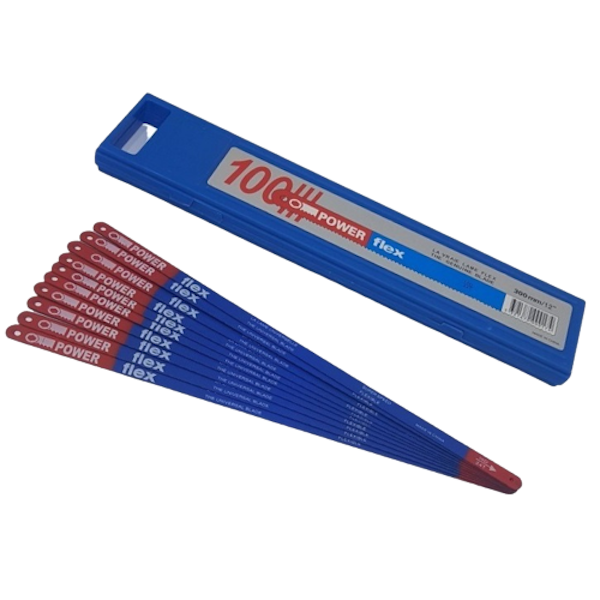Hacksaw Blade: Everything You Need to Know
A hacksaw blade is a long, thin, and flat blade made of hardened steel that is attached to a hacksaw frame. The blade has a series of teeth along its edge that cut through different types of materials. They are commonly used in metalworking, plumbing, carpentry, and other industrial and DIY applications.
Types of Hacksaw Blades:
There are various types of big hacksaw blades available in the market(Dubaibm), and they differ in terms of the type of material they can cut and the size of their teeth.
- Bi-Metal Hacksaw Blades: They are made of two different types of metals, such as high-speed steel and high-carbon steel, welded together. These blades are durable and can cut through a wide range of materials, including metal, plastic, and wood.
- High-Speed Steel Hacksaw Blades: They are made of a special type of steel that can withstand high temperatures and remain sharp for an extended period. These blades are ideal for cutting hard and dense materials, such as stainless steel and other alloys.
- Carbon Steel Hacksaw Blades: The most prevalent kind of hacksaw blade is carbon steel. They are made of a high-quality steel alloy that can be cut through soft materials, such as wood, plastic, and non-ferrous metals.
Hacksaw Blade Teeth:
Also, Several sorts of teeth are available in hexa blades, and the type of teeth influences the kind of material that may be cut by the blade.
- Regular Teeth: Regular teeth are the most common type of hacksaw blade teeth. They have teeth that are evenly spaced and the same size. Soft materials, like wood and plastic, can be sliced with these teeth.
- Wavy Teeth: Wavy teeth have teeth that are not evenly spaced and have different sizes. Hard materials like metal and metallurgy may be sliced using these teeth.
- Skip Teeth: Skip teeth have teeth that are widely spaced and a larger size than regular teeth. These teeth are suitable for cutting soft and thin materials, such as aluminum and brass.
Blade Length and Width:
Hacksaw blades and Olfa Cutter come in different lengths and widths, and the size of the blade determines the type of material it can cut. The length of the blade is measured from the tip of the teeth to the end of the blade. While the width of the blade is measured from one end of the blade to the other end.
Maintaining Your Hack Saw Blade:
At this time, maintaining your hack saw blade is important to ensure that it remains sharp and effective for longer. Here are some tips to help you maintain your hacksaw blade:
- Clean the Blade: After each use, it’s important to clean your hack saw blade with a soft cloth or wire brush to remove any debris or rust. This will prevent the blade from becoming dull and keep it in good condition.
- Lubricate the Blade: Using a lubricant on your big hacksaw blades will help to reduce friction and prevent it from rusting. You can use oil or a silicone-based lubricant to protect the blade.
- Store the Blade Properly: When you’re not using your hacksaw, make sure to store the blade in a dry place to prevent rust from forming. You can also use a blade cover to protect the blade from damage.
- Replace Worn Blades: Over time, hack saw blades will become dull and worn. It’s important to replace them as soon as they show signs of wear, such as dull teeth or broken edges, to ensure that your saw remains effective and safe to use.
By following these tips, you can keep your hexa blade in good condition and ensure that it continues to perform effectively.
Advantages and Disadvantages of Hacksaw Blades:
Furthermore, Hacksaw blades are a common tool used for cutting various materials, including metal, wood, and plastic. Like any tool, they have their advantages and disadvantages.
Advantages:
- Versatility: They can be used to cut a wide range of materials, including metal, wood, plastic, and more.
- Portability: These are small and lightweight, making them easy to transport and use in different locations.
- Precision: With a sharp hacksaw blade, it is possible to make precise cuts in materials, which can be especially important for certain applications.
- Low Cost: These are relatively inexpensive and can be replaced when they become worn or damaged.
Disadvantages:
- Limited Cutting Capacity: They have a limited cutting capacity, meaning they are not suitable for cutting very thick or hard materials.
- Slow Cutting Speed: They require manual effort to cut through materials, which can make the process slow and labor-intensive.
- Blade Breakage: They can break or become damaged if not used correctly. Or if they are exposed to too much force or pressure.
- Maintenance: They require regular maintenance, including cleaning, lubrication, and replacement, to ensure they remain effective.
Overall, big hacksaw blades are useful tools for cutting a range of materials. But they do have some limitations and require careful use and maintenance to remain effective.
Product Features:
- 100 pc/pack
- 12″ x 24 T


Reviews
There are no reviews yet.